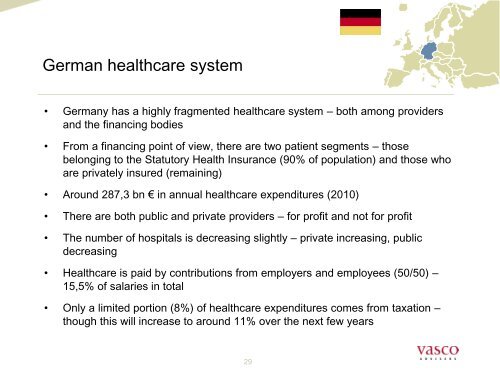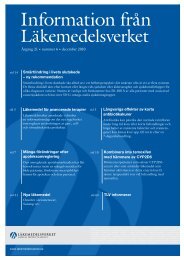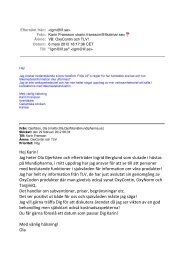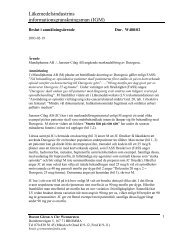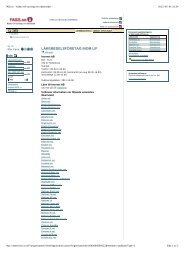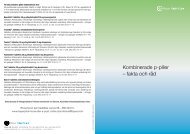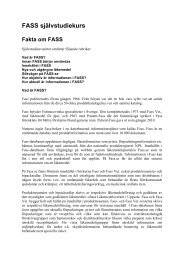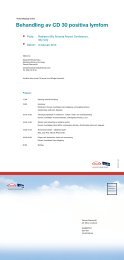- Page 1 and 2: Innovation in European healthcare -
- Page 3 and 4: Introduction If it was up to the NI
- Page 5 and 6: GDP per capita 2011, thUSD Annual G
- Page 7 and 8: Import Technology uptake Export End
- Page 9 and 10: Venture capital flight away from li
- Page 11 and 12: Issues in Sweden: clinical research
- Page 13 and 14: Issues in Sweden: communication and
- Page 15 and 16: Issues in Sweden: reimbursement for
- Page 17 and 18: Summary - the innovation challenges
- Page 19 and 20: InDex Pharmaceuticals InDex Pharmac
- Page 21 and 22: Addressable Patient Population in E
- Page 23 and 24: What conclusions can be drawn from
- Page 25 and 26: Elekta has established a model for
- Page 27: The five European countries 27
- Page 31 and 32: Role of important Government and Of
- Page 33 and 34: Role of important Government and Of
- Page 35 and 36: Germany needs more healthcare for t
- Page 37 and 38: 37 DRG was developed in the US in t
- Page 39 and 40: The base rate varied during the con
- Page 41 and 42: There are public, private for profi
- Page 43 and 44: Financing System of the German SHI
- Page 45 and 46: Central Changes in the German healt
- Page 47 and 48: Innovations in the German Health Ca
- Page 49 and 50: Cost of Pharmaceuticals and Medical
- Page 51 and 52: Three steps for Integration of New
- Page 53 and 54: NUB Process in the German DRG Syste
- Page 55 and 56: Innovative drugs in the outpatient
- Page 57 and 58: Implementation and use of innovativ
- Page 59 and 60: Innovations in the outpatient secto
- Page 61 and 62: Implementation and use of innovatio
- Page 63 and 64: Implementation and use of innovatio
- Page 65 and 66: Implementation and use of innovatio
- Page 67 and 68: New possibility of testing potentia
- Page 69 and 70: Structural Innovations in the Inpat
- Page 71 and 72: Structural Innovations in the Outpa
- Page 73 and 74: During the last ten years two centr
- Page 75 and 76: France The healthcare system in Fra
- Page 77 and 78: Financing of the French health care
- Page 79 and 80:
The French medical device industry
- Page 81 and 82:
The French Medical Devices Market:
- Page 83 and 84:
The average time necessary to get a
- Page 85 and 86:
Shortening the reimbursement proces
- Page 87 and 88:
A successful solution to provide ad
- Page 89 and 90:
2. Pharmaceuticals 89
- Page 91 and 92:
Hospitals carry out more and more o
- Page 93 and 94:
ATU System: Off label use Exemption
- Page 95 and 96:
3. Financial incentives and reimbur
- Page 97 and 98:
The evaluation of new products by t
- Page 99 and 100:
Some particularly expensive drugs a
- Page 101 and 102:
In hospitals, expensive and innovat
- Page 103 and 104:
The impact of T2A on innovation Act
- Page 105 and 106:
The Support for Innovative and Cost
- Page 107 and 108:
Financing innovation through the Pu
- Page 109 and 110:
8 clusters specialised in the healt
- Page 111 and 112:
Medical Devices’ Patenting: less
- Page 113 and 114:
The example of the SAAT Conectus Al
- Page 115 and 116:
The UK The healthcare in the UK is
- Page 117 and 118:
The NHS is underpinned by a set of
- Page 119 and 120:
Today the PCTs are the main purchas
- Page 121 and 122:
Prior to the Health and Social Care
- Page 123 and 124:
Primary Care Trusts (PCTs) have pla
- Page 125 and 126:
The new national level bodies overs
- Page 127 and 128:
The NHS, must deliver efficiency sa
- Page 129 and 130:
PbR was first introduced in 2005/06
- Page 131 and 132:
The design of HRG4 reflects a signi
- Page 133 and 134:
PbR is being incrementally reformed
- Page 135 and 136:
NHS-funded primary care is provided
- Page 137 and 138:
The Quality of Outcomes Framework (
- Page 139 and 140:
The Health and Social Care Act (201
- Page 141 and 142:
The United Kingdom is a major produ
- Page 143 and 144:
£m Healthcare industries are clust
- Page 145 and 146:
Several bodies aim to improve the k
- Page 147 and 148:
National Institute for Health and C
- Page 149 and 150:
Overview of key NICE assessment pro
- Page 151 and 152:
NHS National Technology Adoption Ce
- Page 153 and 154:
“Innovation” has central place
- Page 155 and 156:
Bodies to support innovation in hea
- Page 157 and 158:
The UK is a world-leader in life-sc
- Page 159 and 160:
There still exists large regional v
- Page 161 and 162:
UK rankings and usage as a percenta
- Page 163 and 164:
Multiple structural layers within N
- Page 165 and 166:
NHS lacks control mechanism for imp
- Page 167 and 168:
Short-term budget-cycles often are
- Page 169 and 170:
Actions described by respondents du
- Page 171 and 172:
Actions described by respondents du
- Page 173 and 174:
Actions deriving from the review
- Page 175 and 176:
The following measures were suggest
- Page 177 and 178:
The planned compliance regime is ge
- Page 179 and 180:
Actions to incentivise innovation t
- Page 181 and 182:
NICE’s HTA process: NICE’s stan
- Page 183 and 184:
The implementation of NICE guidelin
- Page 185 and 186:
Implementation: A recommended proce
- Page 187 and 188:
The NHS Technology Adoption Centre
- Page 189 and 190:
The Government has invested a recor
- Page 191 and 192:
The Government’s funding has also
- Page 193 and 194:
Case 2: AstraZeneca and NIHR Cancer
- Page 195 and 196:
The NIHR has also established Healt
- Page 197 and 198:
As part of the Government’s Life
- Page 199 and 200:
All applications for the Biomedical
- Page 201 and 202:
NOCRI has worked together with MRC
- Page 203 and 204:
Academic Health Science Centres (AH
- Page 205 and 206:
What can Sweden learn from the UK?
- Page 207 and 208:
Facts - the proportions of Danish h
- Page 209 and 210:
The Danish healthcare system is pri
- Page 211 and 212:
Public-private investments in R & D
- Page 213 and 214:
The Danish healthcare industry is a
- Page 215 and 216:
Public investments in the future st
- Page 217 and 218:
The public renewal fund is meant to
- Page 219 and 220:
With the responsibility for adminis
- Page 221 and 222:
Organisational chart - the capital
- Page 223 and 224:
The Innovation environments invest
- Page 225 and 226:
Overall the innovation environments
- Page 227 and 228:
Sara established a successful busin
- Page 229 and 230:
Infrastructure for Innovation - The
- Page 231 and 232:
The networks consist of 22 innovati
- Page 233 and 234:
The overall Danish Innovation infra
- Page 235 and 236:
The new market maturing-fund will h
- Page 237 and 238:
The new Danish Innovation strategy
- Page 239 and 240:
Subsidy for new outpatient medicame
- Page 241 and 242:
The evaluation and assessment of ne
- Page 243 and 244:
Cost reduction in expensive hospita
- Page 245 and 246:
The public procurement of Medtech -
- Page 247 and 248:
Innovative public procurement of Me
- Page 249 and 250:
What can Sweden learn from Denmark?
- Page 251 and 252:
The Netherlands are spending more o
- Page 253 and 254:
Health insurers are allowed to make
- Page 255 and 256:
Financial flows in the Dutch health
- Page 257 and 258:
Impact of the reform on providers
- Page 259 and 260:
Impact of the reform on patients/in
- Page 261 and 262:
Impact of the reform The Dutch heal
- Page 263 and 264:
Innovations in the Dutch healthcare
- Page 265 and 266:
The reimbursement system should all
- Page 267 and 268:
Innovations in the Dutch healthcare
- Page 269 and 270:
Innovations in the Dutch healthcare
- Page 271 and 272:
Innovations in the Dutch healthcare
- Page 273 and 274:
Innovations in the Dutch healthcare
- Page 275 and 276:
Innovations in the Dutch healthcare
- Page 277 and 278:
Summary and conclusions 277
- Page 279 and 280:
There is a correlation between a co
- Page 281 and 282:
Conclusions - what can Sweden learn
- Page 283 and 284:
Two general recommendations and one
- Page 285:
www.vascoadvisers.com Supported by


